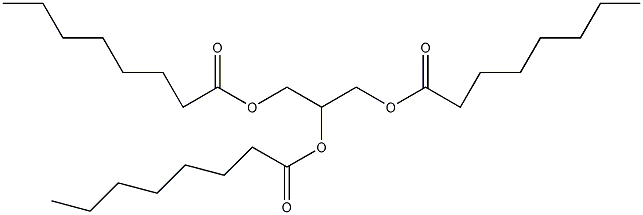Sanxinjing


Structural formula
| Business number | 05J4 |
|---|---|
| Molecular formula | C33H5006 |
| Molecular weight | 470.68 |
| label |
Glyceryl trioctanoate, 1,2,3-Tricapryloylglycerol, 1,2,3-Trioctanoylglycerol, Glycerol tricaprylate, Trioctanoin, Glycerol trioctanoate, Glyceryl tricaprylate |
Numbering system
CAS number:538-23-8
MDL number:MFCD00036236
EINECS number:208-686-5
RTECS number:YJ7700000
BRN number:None
PubChem ID:None
Physical property data
1. Properties: Crystal
2. Density (g/mL, 25/4℃): 0.954
3. Relative density (20℃, 4℃): 0.9540
4. Melting point (ºC): 10
5. Boiling point (ºC, normal pressure): 233
6. Refractive index at room temperature (n 20): 1.4482
7. Refractive index: 1.44817
8. Flash point (ºC): Undetermined
9. Specific rotation (º): Undetermined
10. Autoignition point or ignition temperature (ºC): Undetermined
11. Vapor pressure (kPa, 25ºC): Undetermined
12. Saturated vapor pressure (kPa, 60ºC): Undetermined
13. Heat of combustion (KJ/mol): Undetermined
14. Critical temperature (ºC): Undetermined
15. Critical pressure (KPa): Undetermined
16. Log value of oil-water (octanol/water) partition coefficient: Undetermined
17. Explosion upper limit (%, V/V): Undetermined
18. Explosion lower limit (%, V/V): Undetermined
19. Solubility: Soluble in ethanol , ether, benzene, chloroform and petroleum
Toxicological data
1. Acute toxicity: Rat oral LD50: 33300mg/kg, no detailed description except lethal dose;
Rat abdominal LD: >27800mg/kg, changes in body activity (detailed analysis );
Rat subcutaneous LD: >27800mg/kg, changes body activity (specific analysis);
Rat intravenous LDLo: 4gm/kg, no except lethal dose Detailed description;
Mouse oral LD50: 29600mg/kg, no detailed description except lethal dose;
Mouse abdominal LD50: >27800mg/kg, changes in body activity ( Specific analysis);
Mouse subcutaneous LD: >27800mg/kg, changing body activity (specific analysis);
Mouse intravenous LD50: 3700mg/kg, behavior-muscle Contraction or spasm.
2. Oncogenic data: largeRat oral TDLo: 2600 mL/kg/2Y-I, RTECS standard gastrointestinal tract – tumor;
3. Reproductive toxicity: rat DOSE oral TDLo: 7 days before female mating – 21 days after childbirth Days: 250gm/kgSEX/DURATION, effects on maternal weaning or lactation index, effects on neonates – growth statistics (e.g. %, reduced weight gain).
Ecological data
This substance may be harmful to the environment, and special attention should be paid to water bodies.
Molecular structure data
1. Molar refractive index: 132.41
2. Molar volume (cm3/mol): 485.0
3. Isotonic specific volume (90.2K ): 1177.9
4. Surface tension (dyne/cm): 34.7
5. Polarizability (10-24cm3): 52.49
Compute chemical data
1. Reference value for hydrophobic parameter calculation (XlogP): 8.9
2. Number of hydrogen bond donors: 0
3. Number of hydrogen bond acceptors: 6
4. Number of rotatable chemical bonds: 26
5. Number of tautomers: none
6. Topological molecule polar surface area 78.9
7. Number of heavy atoms: 33
8. Surface charge: 0
9. Complexity: 461
10. Number of isotope atoms: 0
11. Determine the number of atomic stereocenters: 0
12. Uncertain number of atomic stereocenters: 0
13. Determine the number of chemical bond stereocenters: 0
14. Number of uncertain chemical bond stereocenters: 0
15. Number of covalent bond units: 1
Properties and stability
It will not decompose or react if stored as required, keep away from oxides.
Storage method
Should be kept sealed.
Synthesis method
None yet
Purpose
For biochemical research.